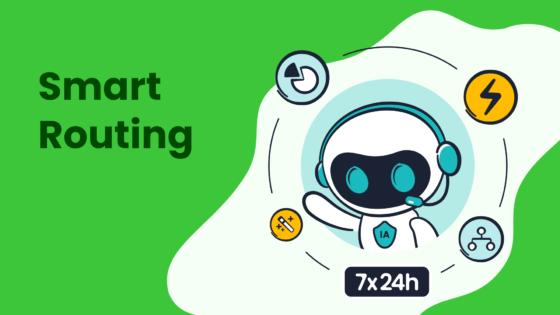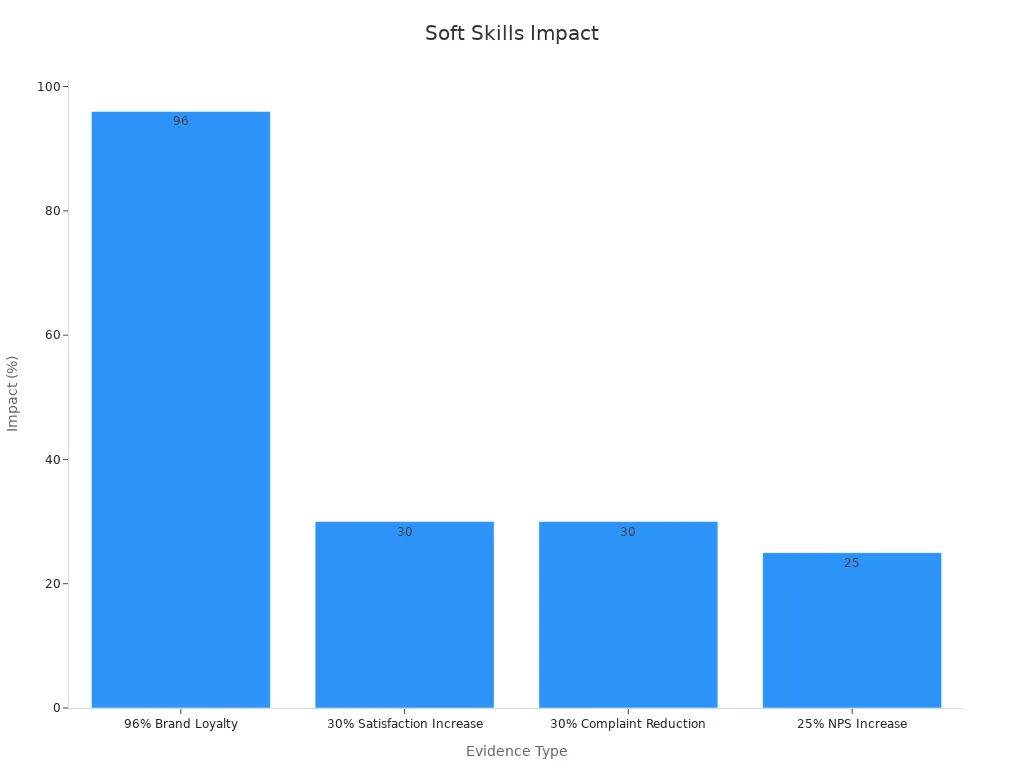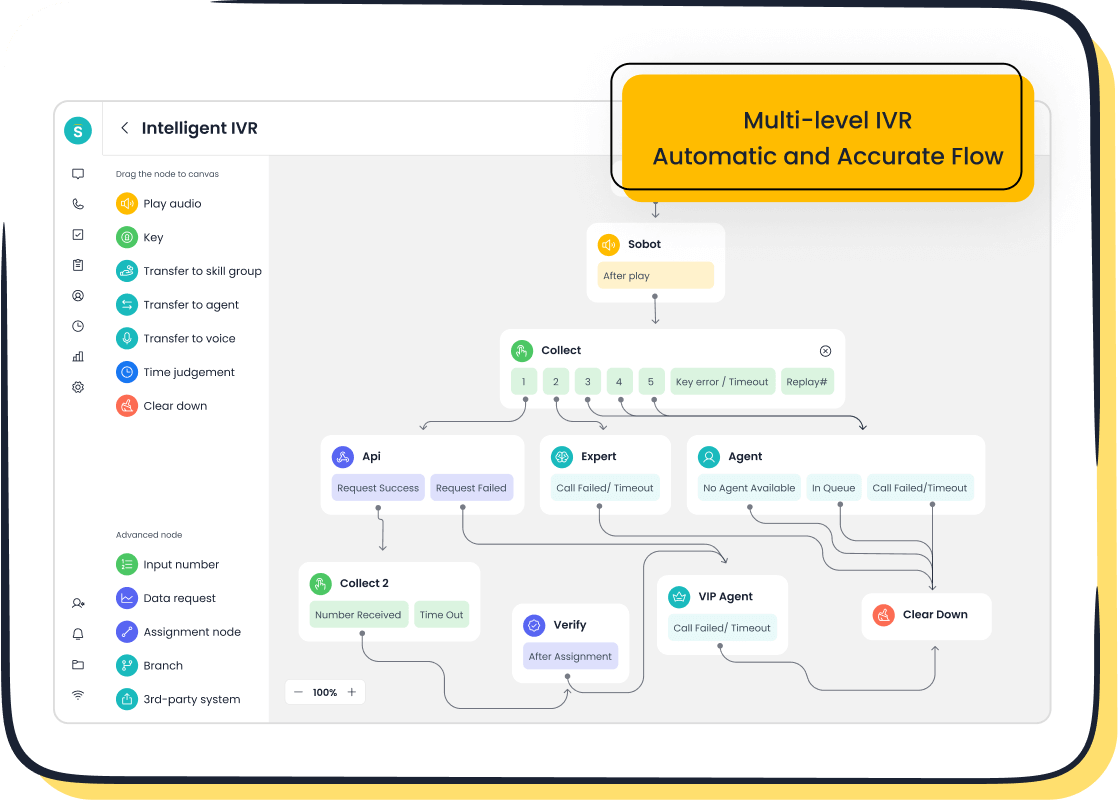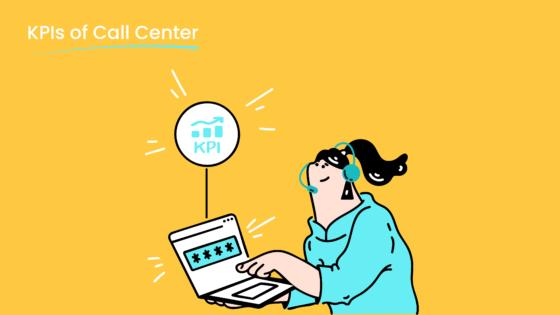Essential Skills for Customer Service Excellence in 2025

Customer service in 2025 isn’t just about answering questions—it’s about creating memorable experiences. With 93% of teams reporting higher customer expectations, you can’t afford to rely on outdated methods. Customers now expect faster responses, seamless interactions, and personalized support. Did you know 89% of people are more likely to make another purchase after a great experience? That’s why mastering the right skills related to customer service is critical.
Technology plays a big role too. Companies like Sobot are transforming how businesses interact with customers by offering advanced tools like AI-powered voicebots and unified workspaces. These innovations help you deliver exceptional service while staying efficient. Whether you're in retail, gaming, or financial services, the right skills and tools can make all the difference in meeting rising expectations.
Why Customer Service Skills Matter in 2025
Defining Skills Related to Customer Service
In 2025, skills related to customer service go beyond just answering questions. They’re about creating meaningful connections and solving problems effectively. You need to master both soft and hard skills to thrive in this evolving landscape. For example, empathy helps you understand customer emotions, while adaptability ensures you can handle rapid changes in technology and expectations.
Customer service representatives must also excel in active listening and clear communication. These skills ensure customers feel heard and valued. On the technical side, proficiency with tools like AI-powered voicebots or unified workspaces—such as those offered by Sobot—can streamline your workflow and improve customer satisfaction.
A customer-centric mindset ties all these skills together. It’s about putting the customer at the heart of every interaction, ensuring they leave with a positive impression. After all, great customer service isn’t just a skill—it’s an art.
The Role of Customer Service Skills in Business Success
Strong customer service skills are the backbone of business growth. Why? Because happy customers stick around. They’re more likely to buy again and recommend your brand to others.
- Businesses that prioritize customer needs often outperform competitors.
- 60% of customers choose brands based on expected service quality.
- Personalizing interactions boosts retention and drives sales.
Take Samsung, for instance. By using Sobot’s all-in-one contact center solution, they unified communication channels and improved agent efficiency by 30%. This led to a 97% customer satisfaction rate, proving how great customer service can transform a business.
When you invest in your customer service representatives, you’re not just improving interactions—you’re building loyalty, trust, and long-term success.
Adapting to Changing Customer Expectations
Customer expectations are shifting fast. In 2025, they want more than quick fixes. They expect personalized, proactive, and seamless experiences.
- 71% of customers demand personalized interactions.
- 76% feel frustrated when service lacks a personal touch.
- AI and hyper-personalization are driving a shift from reactive to proactive support.
To keep up, you need to embrace tools that enhance your adaptability. Sobot’s AI-powered voicebots, for example, can handle repetitive queries, freeing you to focus on complex issues. This not only improves efficiency but also ensures customers feel valued.
By staying ahead of these changes, you can deliver great customer service that meets—and exceeds—expectations.
Essential Soft Skills for Customer Service Excellence

Empathy: Building Strong Customer Relationships
Empathy is the cornerstone of great customer service. When you genuinely understand your customers’ emotions, you can connect with them on a deeper level. This connection builds trust and loyalty, which are essential for long-term relationships.
Imagine a customer reaching out after a frustrating experience. If you respond with empathy, acknowledging their feelings and offering a solution, you’re not just solving their problem—you’re showing them you care. This approach transforms interactions into opportunities to strengthen relationships.
Data backs this up. A survey revealed that 62% of consumers believe brands need to care more about them, while 73% say positive experiences significantly influence their purchasing decisions. Empathy isn’t just a nice-to-have; it’s a must-have for building loyalty.
Sobot’s AI-powered voicebots can even help you demonstrate empathy. By handling repetitive queries, they free you to focus on supporting irate customers with personalized care. This ensures every interaction feels meaningful and human.
| Evidence | Description |
|---|---|
| 80% of consumers | See trust as a deciding factor in their purchase decisions, emphasizing the role of empathy in building trust. |
| Customers rating experience 5/5 stars | Are more than twice as likely to buy again, showcasing the impact of empathetic customer experiences on loyalty. |
Communication: Active Listening and Clear Messaging
Effective communication is more than just talking—it’s about listening actively and delivering clear messages. When you listen to your customers, you show them their concerns matter. This builds rapport and ensures you fully understand their needs before offering solutions.
Active listening enhances customer satisfaction, especially in tricky situations like service recovery. For example, listening to a customer’s concerns before apologizing can make them feel valued and lead to better outcomes. It’s a simple yet powerful way to improve interactions.
Clear communication is equally important. Customers appreciate straightforward answers that solve their problems without confusion. Whether you’re explaining a product feature or guiding them through a process, clarity ensures they leave the conversation satisfied.
Sobot’s unified workspace makes this easier. It consolidates customer data, giving you the context needed for clear communication. You can access past interactions, preferences, and concerns—all in one place—so you’re always prepared to deliver the right message.
- Benefits of Active Listening:
- Improves customer satisfaction in service recovery situations.
- Leads to higher behavioral intentions, like tipping or repeat purchases.
- Reduces frustration by addressing concerns effectively.
Emotional Intelligence: Managing Interactions Effectively
Emotional intelligence skills are your secret weapon for managing customer interactions. They help you navigate challenging situations, like supporting irate customers, with grace and professionalism.
When you understand your own emotions and those of your customers, you can respond thoughtfully instead of reacting impulsively. This creates a positive experience, even in difficult conversations. Emotional intelligence also helps you stay calm under pressure, ensuring you provide consistent service.
Johnson & Johnson’s success story highlights the power of emotional intelligence. After training their teams in emotional intelligence skills, they saw a 30% improvement in customer satisfaction scores. This shows how understanding emotions can directly impact service quality.
Sobot’s real-time monitoring tools can support your emotional intelligence efforts. By analyzing call data, you can identify patterns in customer behavior and adjust your approach accordingly. This ensures every interaction is tailored to the customer’s needs.
| Evidence Description | Impact |
|---|---|
| 96% of customers state that the quality of customer service influences their loyalty to a brand. | Indicates the importance of customer service quality in brand loyalty. |
| 25% increase in Net Promoter Score (NPS) after implementing soft skills training. | Reflects improved customer advocacy due to enhanced service. |

Problem Solving: Creative Solutions for Customer Issues
Problem-solving skills are the backbone of exceptional customer service. When customers reach out with issues, they expect you to provide creative and effective solutions. This is where your ability to think outside the box becomes invaluable. Whether it’s resolving a billing error or troubleshooting a technical glitch, your approach can make or break the customer experience.
Creative problem-solving isn’t just about fixing issues—it’s about doing so in a way that leaves a lasting positive impression. For example, Gore Mutual tackled complex claims challenges by engaging customers and brokers in workshops and interviews. This collaborative approach led to the creation of ClaimCare, a streamlined claims process that significantly improved customer satisfaction. You can adopt similar methods by involving your team and customers in brainstorming sessions to uncover innovative solutions.
Sobot’s AI-powered voicebots can also enhance your problem-solving abilities. These tools handle repetitive queries, freeing you to focus on more complex issues. Plus, features like real-time monitoring and analytics help you identify patterns and address root causes effectively. By leveraging such technology, you can achieve first contact resolution more often, boosting customer trust and loyalty.
Pro Tip: Always approach problems with a calm mindset. Stress management skills are crucial when dealing with frustrated customers. Staying composed helps you think clearly and find the best solutions.
| Key Benefits of Creative Problem Solving | Description |
|---|---|
| Builds customer trust | Customers appreciate thoughtful solutions. |
| Enhances team collaboration | Encourages innovative ideas through teamwork. |
| Improves efficiency | Resolves issues faster with fewer resources. |
Adaptability: Thriving in Dynamic Environments
Adaptability is your superpower in today’s fast-changing world. Customer service environments are constantly evolving due to new technologies, economic shifts, and diverse customer needs. To thrive, you need to embrace change and stay flexible.
Being adaptable means more than just adjusting to new tools or processes. It’s about having a mindset that welcomes learning and growth. For instance, when companies introduce innovative systems, employees who adapt quickly often excel. This is especially true in customer service, where multitasking and time management skills are essential. You might need to juggle multiple tasks, like answering calls, responding to emails, and managing live chats—all while maintaining a high level of service.
Sobot’s unified workspace simplifies multitasking by consolidating customer data and communication channels into one platform. This allows you to switch between tasks seamlessly, saving time and reducing errors. Additionally, features like smart call routing ensure you’re always connected to the right customer at the right time.
Did You Know? Adaptable employees are often seen as valuable assets. They’re better at solving problems, planning for new situations, and navigating uncertainties. This makes them indispensable in any workplace.
Here’s why adaptability matters in customer service:
- It helps you respond to technological advancements and economic changes.
- It enables you to work effectively with diverse teams and viewpoints.
- It ensures you can handle unexpected challenges with confidence.
By cultivating adaptability, you’ll not only improve your performance but also position yourself as a leader in your field.
Key Hard Skills for Modern Customer Service
Technological Literacy: Mastering Tools and Platforms
In 2025, technological literacy is no longer optional—it’s essential. As customer service becomes more reliant on advanced tools, your ability to navigate platforms like CRM systems, AI-powered bots, and unified workspaces can set you apart. These tools streamline workflows, reduce response times, and improve the overall customer experience.
For instance, Sobot’s unified workspace consolidates customer data and communication channels into one platform. This makes it easier for you to access relevant information and provide personalized support. Whether you’re managing live chats, emails, or calls, mastering such tools ensures you deliver seamless service.
The numbers back this up: A 2024 study by CourseCareers found that graduates with technological proficiency were 40% more likely to secure roles requiring these skills. Companies employing tech-savvy professionals also reported a 20% improvement in employee satisfaction. Clearly, technical proficiency with CRM systems and other platforms isn’t just a nice-to-have—it’s a must-have.
Pro Tip: Stay ahead by exploring training programs or certifications that enhance your tech skills. Platforms like HubSpot Academy and LinkedIn Learning offer courses tailored to customer support professionals.
Data Analysis: Leveraging Insights for Better Service
Data analysis is the secret weapon for improving customer support. By analyzing customer interactions, you can uncover patterns, predict needs, and tailor your approach. This not only enhances the customer experience but also boosts efficiency.
Imagine having access to real-time analytics that show which issues customers face most often. With tools like Sobot’s monitoring and analysis features, you can identify trends and address root causes proactively. This helps you resolve issues faster and improve first-contact resolution rates.
According to HubSpot’s 2024 State of Service report, organizations that leverage data analytics see a 3%-5% increase in revenue. They’re also six times more likely to retain customers. As a result, investing in data-driven strategies gives you a competitive edge.
“Data analytics emerges as the pivotal element, enabling companies to unearth invaluable insights about customers from the vast sea of data. Incorporating data analytics into their operations empowers organizations to gain a strategic advantage in the market, refine marketing strategies, and deliver tailored experiences to diverse segments of their target audience.”
By mastering data analysis, you’re not just solving problems—you’re anticipating them. This proactive approach builds trust and loyalty, ensuring customers keep coming back.
Omnichannel Support: Seamless Customer Experiences
Omnichannel support expertise is the key to meeting modern customer expectations. Customers want to interact with your brand on their terms—whether through social media, email, or live chat. Providing a seamless experience across these channels ensures they feel valued and understood.
Take Disney, for example. Their My Disney Experience app integrates planning, ticketing, and in-park interactions into one platform. This omnichannel approach enhances customer engagement and simplifies the user journey. Similarly, Sobot’s omnichannel solutions unify communication channels, allowing you to manage interactions effortlessly. Whether it’s voice calls, WhatsApp messages, or chatbot queries, you can handle them all from a single interface.
The benefits are clear: Companies like Sephora have seen a 75% increase in mobile orders by integrating digital and in-store experiences. Bank of America’s chatbot has handled over 1 billion interactions, improving accessibility and satisfaction. These examples highlight how omnichannel support expertise drives better outcomes for both customers and businesses.
Did You Know? By 2024, 70% of customer interactions will involve a mix of automated self-service and live agents. This shift underscores the importance of mastering omnichannel tools to stay competitive.
To excel in omnichannel support, focus on tools that integrate seamlessly with your existing systems. Sobot’s solutions, for instance, offer AI-driven automation and real-time analytics, helping you deliver consistent service across all touchpoints.
Knowledge Management: Efficient Information Sharing
Efficient knowledge management is the backbone of great customer service. Imagine trying to help a customer without the right information at your fingertips. It’s frustrating for both you and the customer. That’s why sharing information seamlessly across teams and systems is so important.
When you have access to a centralized knowledge base, you can find answers quickly. This reduces response times and ensures customers get accurate solutions. For example, Sobot’s unified workspace consolidates customer data, past interactions, and FAQs into one platform. You don’t have to waste time switching between systems. Everything you need is right there, making your job easier and your service faster.
Pro Tip: Keep your knowledge base updated regularly. Outdated information can lead to mistakes and unhappy customers.
Here’s how efficient knowledge management helps you:
- Speeds up problem-solving: You can resolve issues faster when you have the right information.
- Improves accuracy: Customers trust you more when your answers are correct.
- Boosts collaboration: Teams work better together when they share knowledge effectively.
Companies that prioritize knowledge management see big results. A study by Deloitte found that businesses with strong knowledge-sharing practices are 20% more productive. They also report higher customer satisfaction rates.
Sobot’s solutions take this a step further. With features like real-time monitoring and AI-powered voicebots, you can access insights instantly. These tools help you identify patterns in customer queries and share solutions across your team. It’s like having a supercharged knowledge base that evolves with your needs.
AI Integration: Enhancing Service with Automation
AI is changing the game in customer service. It’s not just about automating tasks—it’s about enhancing the entire experience. Imagine having a virtual assistant that works 24/7, answers routine questions, and even senses customer emotions. That’s the power of AI.
Here’s what AI can do for you:
- 🕒 24/7 Availability: AI chatbots never sleep. They’re always ready to help customers, even during holidays.
- ⚡ Faster Response Times: Routine inquiries get instant answers, freeing you to focus on complex issues.
- 💰 Cost Efficiency: Automating tasks reduces operational costs, saving your company money.
- 🌍 Multilingual Support: AI tools can communicate in multiple languages, making global service easier.
Take a look at how companies are using AI to improve service:
| Company | AI Implementation | Results |
|---|---|---|
| XYZ Corporation | AI chatbots for instant responses | Enhanced customer experience by providing immediate help and seamless transitions to agents. |
| ABC Inc. | AI-driven voice assistants | Improved personalization and customer trust through tailored guidance. |
| Delta Airlines | Predictive service model | 12% increase in customer satisfaction and 10% reduction in service-related complaints. |
| AT&T | AI support automation | 80% of inquiries resolved by chatbots, leading to 25% reduction in operational costs. |
| Motel Rocks | Advanced AI for customer mood sensing | Allowed agents to focus on complex queries while improving overall service efficiency. |
Sobot’s AI-powered voicebots are a perfect example of this. They handle repetitive queries, recognize customer intent, and even analyze sentiment. This means you can focus on providing personalized care while the bots take care of routine tasks. Plus, with real-time analytics, you can track performance and make improvements on the fly.
Did You Know? Companies using AI see up to a 30% increase in efficiency. It’s not just about saving time—it’s about delivering better service.
By integrating AI into your workflow, you’re not just keeping up with trends—you’re setting the standard for exceptional customer service. Whether it’s through predictive models or intelligent routing, AI helps you stay ahead of customer needs and expectations.
Leveraging Sobot’s Voice/Call Center for Skill Development

Intelligent IVR for Streamlined Customer Interactions
Imagine calling a company and being greeted by a system that understands your needs instantly. That’s the magic of intelligent IVR (Interactive Voice Response). It’s not just about routing calls—it’s about creating smoother, faster, and more satisfying customer experiences.

Sobot’s Intelligent IVR takes this to the next level. With features like drag-and-drop menu building and real-time updates, you can customize workflows to match your business needs. This means customers get directed to the right agent or department without unnecessary delays. Plus, advanced technologies like natural language processing ensure the system understands customer intent, making interactions feel more human.
Real-world examples prove how effective this can be. A Canadian telecommunications company revamped its outdated IVR system and saw an 8% increase in calls resolved through self-service. They also achieved a 93% rise in first-call resolution rates, showing how modern IVR systems can transform customer service. With Sobot’s solution, you can achieve similar results, reducing call handling times and boosting satisfaction.
Pro Tip: Use IVR to collect customer feedback automatically. It’s a simple way to improve your service while saving time.
Unified Workspace for Efficient Call Management
Managing multiple calls and customer data can feel overwhelming. That’s where a unified workspace comes in. It brings everything—calls, messages, and customer information—into one easy-to-use platform.

Sobot’s unified workspace simplifies your workflow. You can access customer histories, track ongoing issues, and even manage tickets—all from a single screen. This reduces the time spent switching between tools and ensures you’re always prepared for the next interaction.
The benefits are clear:
- Companies using unified workspaces report a 50% increase in productivity.
- Tool consolidation can save businesses $1–$20 per user per month.
- Mean time to resolution (MTTR) drops significantly, improving customer satisfaction.
By adopting Sobot’s solution, you’ll not only save time but also reduce operational complexity. It’s like having a personal assistant that keeps everything organized for you.
AI-Powered Voicebot for Enhanced Problem Solving
AI-powered voicebots are game-changers in customer service. They handle routine inquiries, freeing you to focus on complex problems that require a human touch.

Sobot’s AI-powered voicebot goes beyond basic automation. It uses real-time transcription to capture conversations accurately, making note-taking a thing of the past. It also analyzes customer interactions to provide actionable insights, helping you make better decisions faster.
Here’s what makes AI voicebots so effective:
- They’re available 24/7, ensuring customers always get help when they need it.
- They reduce abandonment rates by handling inquiries instantly.
- They gather and analyze data to improve your problem-solving strategies.
For example, companies using AI voicebots have seen a 25% reduction in operational costs and a significant boost in customer satisfaction. With Sobot’s voicebot, you can deliver consistent, high-quality service while staying efficient.
Did You Know? Voicebots can even detect customer sentiment, helping you tailor your responses for a more personalized experience.
Real-Time Monitoring and Analytics for Skill Improvement
Real-time monitoring and analytics are game-changers for improving customer service skills. Imagine having instant access to live data that shows how your team is performing. You can spot issues as they happen, make quick decisions, and keep service quality consistent throughout the day. This kind of agility isn’t just helpful—it’s essential in today’s fast-paced customer service world.
Supervisors benefit the most from real-time insights. They can track service levels, monitor adherence to schedules, and adjust workflows on the fly. For example, if call wait times spike unexpectedly, you can reassign agents to handle the load. This keeps customers happy and ensures your team stays efficient.
Analyzing past interactions is just as important. By reviewing raw customer data, you can uncover patterns in customer sentiment and behavior. These insights help you refine your strategies and improve workflows. Over time, this leads to better team performance and a smoother customer experience.

Sobot’s Voice/Call Center makes this process seamless. Its real-time monitoring tools let you track call data, agent performance, and customer sentiment—all in one place. You can even use its analytics to identify trends and optimize your team’s approach. For instance, if customers frequently ask about a specific product feature, you can train your team to address it proactively.
Pro Tip: Use real-time analytics to identify skill gaps in your team. This helps you focus training efforts where they’re needed most.
Here’s why real-time monitoring matters:
- It improves responsiveness by providing live data for quick decision-making.
- It enhances operational agility, allowing you to adapt to changing customer needs.
- It boosts service quality by helping you refine workflows and strategies.
With tools like Sobot’s monitoring and analytics features, you’re not just managing customer service—you’re mastering it.
Strategies for Continuous Learning and Adaptability
Embracing Lifelong Learning in Customer Service
Customer service is evolving faster than ever. To keep up, you need to embrace lifelong learning. This mindset ensures you stay ahead of trends, tools, and customer expectations. Think of it as a way to future-proof your career.
Lifelong learning doesn’t mean going back to school. It’s about staying curious and open to new ideas. For example, you could explore webinars, attend industry events, or even join peer groups to exchange insights. These activities help you sharpen skills like active listening and problem-solving, which are essential for delivering exceptional service.
Companies that encourage continuous learning see real benefits. Employees who actively learn tend to adapt better to new technologies and processes. Sobot’s unified workspace, for instance, simplifies multitasking and time management. By mastering tools like this, you can handle customer inquiries more efficiently while staying focused on growth.
Pro Tip: Dedicate 15 minutes daily to learning something new. Small, consistent efforts add up over time.
Leveraging Online Courses and Certifications
Online courses and certifications are game-changers for upskilling. They’re flexible, affordable, and packed with practical knowledge. Whether you’re learning about AI-powered tools or improving your communication skills, these programs can boost your expertise.
Studies highlight their impact:
| Study Source | Findings | Impact |
|---|---|---|
| 2021 ATD Study | Companies investing in certification-based training saw a 218% increase in revenue per employee | Significant revenue growth |
| World Economic Forum (2020) | 50% of employees will need reskilling by 2025; short-term certifications are effective | Highlights the necessity of certifications |
| Harvard Business Review | Employees engaged in microlearning completed training 30% faster and retained more knowledge | Efficiency and retention improvement |
Platforms like Coursera and LinkedIn Learning offer courses tailored to customer service professionals. You can even explore certifications in tools like Sobot’s AI-powered voicebots to enhance your technical skills. These credentials not only improve your performance but also make you stand out in the job market.
Did You Know? Employees with certifications are 30% more likely to get promoted.
Building a Feedback-Driven Culture
Feedback is the fuel for growth. When you create a culture that values feedback, everyone benefits—employees, customers, and the business. Regular feedback helps you identify strengths, address weaknesses, and continuously improve.
Here’s how feedback drives better performance:
- Regular feedback improves employee performance by 12.5%.
- Engaged employees are 3.2x more motivated to deliver outstanding work.
- Positive feedback cultures lead to higher customer satisfaction ratings.
For example, Sobot’s real-time monitoring tools allow supervisors to provide immediate feedback during customer interactions. This helps agents refine their skills, whether it’s active listening or multitasking and time management. Over time, this approach boosts team morale and enhances service quality.
Pro Tip: Encourage peer-to-peer feedback. It builds trust and fosters collaboration.
| Evidence Type | Findings |
|---|---|
| Customer Satisfaction | Higher levels of customer satisfaction ratings are predicted by department culture. |
| Vehicle Sales | Positive culture correlates with increased vehicle sales, mediated by customer satisfaction. |
By prioritizing feedback, you create a workplace where everyone feels valued and empowered to grow.
Staying Updated on Industry Trends and Innovations
Staying ahead in customer service means keeping up with the latest industry trends and innovations. The world of customer expectations and technology evolves quickly. If you don’t stay informed, you risk falling behind. But how do you keep up? It’s simpler than you think.
Start by following industry reports and blogs. These resources often highlight emerging trends, like the rise of AI-powered tools or shifts in customer behavior. For example, trend analysis helps businesses predict changes by examining historical data. It also reveals what customers want, allowing you to tailor your services. Companies that understand these trends often see higher satisfaction and loyalty from their customers.
Networking is another great way to stay updated. Attend webinars, join online forums, or participate in industry events. These platforms connect you with experts who share insights about innovations shaping customer service. You’ll learn about tools like Sobot’s AI-powered voicebots, which streamline interactions and improve efficiency. By adopting such technologies, you can stay competitive and deliver exceptional service.
Don’t forget to analyze your own data. Tools like Sobot’s real-time monitoring and analytics provide valuable insights into customer preferences and market opportunities. They help you spot patterns and adapt your strategies. For instance, if you notice a growing demand for omnichannel support, you can implement solutions like Sobot’s unified workspace to meet those needs.
Here’s why staying updated matters:
- It improves forecasting accuracy, helping you plan better.
- It enhances customer satisfaction by aligning services with preferences.
- It uncovers opportunities to innovate and stand out.
Pro Tip: Dedicate 15 minutes daily to reading industry news or exploring new tools. Small efforts can lead to big results.
By staying informed, you’ll not only meet customer expectations but also set new standards for excellence in customer service.
Mastering customer service skills in 2025 means blending empathy, communication, and problem-solving with technological expertise. Soft skills build trust, while hard skills like data analysis and AI integration drive efficiency. Together, they create a winning formula for customer satisfaction.
Tools like Sobot’s unified workspace and AI-powered voicebots make this balance easier to achieve. They simplify workflows and help you focus on what matters most—delighting your customers.
The future of customer service belongs to those who adapt and grow. Invest in your skills, embrace innovation, and stay ahead of the curve. Your career—and your customers—will thank you.
FAQ
What is the uptime of Sobot’s Voice/Call Center system?
Sobot’s Voice/Call Center system boasts an impressive uptime of 99.99%, ensuring reliable operations for businesses worldwide. This stability supports seamless customer interactions, even during peak hours. Learn more about its features here.
Can Sobot integrate with my existing CRM system?
Yes, Sobot’s solutions integrate effortlessly with popular CRM systems like Salesforce and Shopify. This ensures smooth workflows and centralized customer data management, saving you time and boosting efficiency.
How does Sobot’s AI-powered Voicebot improve customer service?
Sobot’s Voicebot handles repetitive queries, recognizes customer intent, and analyzes sentiment. This frees you to focus on complex issues while delivering faster, personalized service. It’s available 24/7, ensuring customers always get help when they need it.
Does Sobot support global telephony contacts?
Absolutely! Sobot’s Voice/Call Center provides access to phone numbers worldwide. With 110 points of presence across 93 cities, you can connect with customers globally without hassle.
How can I track and improve agent performance using Sobot?
Sobot’s real-time monitoring tools let you track call data, agent performance, and customer sentiment. Use analytics to identify trends, refine workflows, and provide targeted training for skill improvement. This ensures consistent service quality.
See Also
Essential Strategies for Effective Call Center Quality Management
Transforming Customer Support with AI-Powered Service Agents
Discovering Leading Cloud Contact Centers for 2025
The 10 Best Customer Service Software Solutions for 2024
Comprehensive Guide to Quality Management Systems in Call Centers
